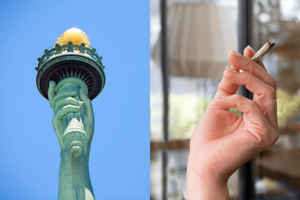Torches of Freedom: Difference between revisions
From BurnZero
mNo edit summary |
mNo edit summary |
||
| (One intermediate revision by the same user not shown) | |||
| Line 1: | Line 1: | ||
[[File:Torches of Freedom.png|alt=Torches of Freedom|thumb|'''Figure 1'''. By linking the Women's Liberation movement to the Statue of Liberty, Edward Bernays figure he could sell more cigarettes.]] | [[File:Torches of Freedom.png|alt=Torches of Freedom|thumb|'''Figure 1'''. By linking the Women's Liberation movement to the Statue of Liberty, Edward Bernays figure he could sell more cigarettes.]] | ||
'''During the first wave of feminism in the United States at the beginning of the 20th century, the phrase "''Torches of Freedom''" was a phrase used to promote smoking among women by capitalising on their hopes for a better life.''' It was | '''During the first wave of feminism in the United States at the beginning of the 20th century, the phrase "''Torches of Freedom''" was a phrase used to promote smoking among women by capitalising on their hopes for a better life.''' It was [[Framing|framed]] that that smoking cigarettes represented women's independence and equality with males. The psychotherapist A. A. Brill coined the phrase to describe women's innate need to smoke, and [[Edward Bernays]] exploited it to persuade women to smoke in public against social taboos. | ||
Latest revision as of 21:06, 17 October 2023
During the first wave of feminism in the United States at the beginning of the 20th century, the phrase "Torches of Freedom" was a phrase used to promote smoking among women by capitalising on their hopes for a better life. It was framed that that smoking cigarettes represented women's independence and equality with males. The psychotherapist A. A. Brill coined the phrase to describe women's innate need to smoke, and Edward Bernays exploited it to persuade women to smoke in public against social taboos.
